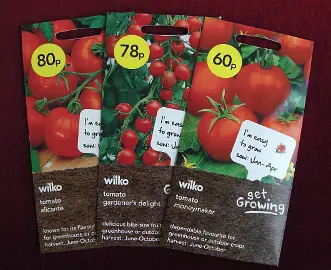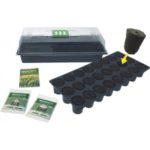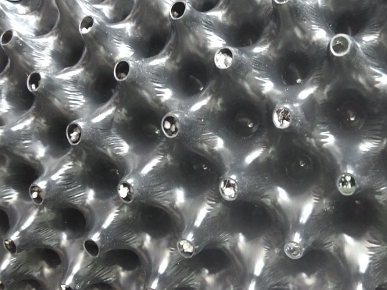Welcome to the first Tomato Growing Newsletter of 2013!
Tomato Growing Season
I’m really excited about this coming season for a number of reasons.
Firstly, because I’m growing some of the old traditional varieties that got me started … a trip down memory lane.
Secondly, because I have a number of new methods up my sleeve that should reduce the growing time, improve yield and make a successful crop much more likely – even in a poor summer!
I’m not talking about a brand new chemical feed or anything that is “unearthly”, but refining the process of growing tomatoes and getting the optimum results.
The aim … lots of ripe fruit that taste like the best home-grown tomatoes should taste at the end of the season, and hopefully, well before the end of the season too!
Choosing Tomato Varieties
Choosing which varieties to grow and deciding on the growing media of compost, or alternatives such as jiffy pellets or root-it sponges are decisions to make soon.
As someone who finds it difficult to make up his mind, I shall probably sow too many seeds, grow too many plants and spend more money than intended, but it’s my hobby (obsession) and I love it!
Deal of the Week …

That’s £1.58 for Alicante, Gardener’s Delight & Moneymaker!
Short Season
Living in a “short season” area, as those of us who live in the UK will know, means that getting a good crop in a poor summer is a great challenge.
We had three or four consecutive summers of wet weather in previous years, but last season was different … very little sunshine, especially in the late spring and early summer when plants needed plenty of light for strong growth.
This meant that the larger heirloom varieties, which usually take a bit longer to mature, were far from fully grown by the end of the season. Even some of the cherry varieties struggled to mature in the low light of last season’s weather conditions.
Lessons learned … if this season is similar, the “quick to mature” cherry varieties are probably the most likely to succeed.
Here are a few cherry tomato varieties that have always matured quickly in my garden over the years.
| Tall - Indeterminate - Cordon | Bush - Determinate |
|---|---|
| Sungold F1 | Tumbler F1 |
| Black Cherry | Red Alert |
| Piccolo | Maskotka |
Tomato Taste
In my experience almost every tomato that is grown in the right conditions will taste fabulous and in a later newsletter we’ll discuss some of the reasons why a bland, watery taste can get the better of your tomatoes – heaven forbid!
When To Sow
I always start too early and end up with too many plants and not enough room to grow them properly – I must try harder to resist the temptation this season!
The best time to sow, in my experience, is from the middle of March to the first week of April for cold greenhouse and outdoor growing.
If you have grow lights then of course you could start earlier. Some varieties can cope with low light levels and shorter days better than others.
Propagation
The most economical way, if you grow around 30 or more plants, is probably a seed tray filled with compost. A lid is also useful to retain humidity when the seedlings germinate. The humidity inside the lid helps the seedlings discard their seed husks and helps prevent stress as the seedlings acclimatise.
The least expensive method is to use grow pots which you will probably find in discount stores. These include seeds and a small amount of compost – just sow in the pot and that’s it!
Jiffy pellets are also a very good way to germinate seeds and you can buy these included with a propagator. The windowsill type is very popular and useful of course.
You can buy peat or peat free (coir) pellets, some of which are “pre-loaded” with dried feed, if not, a “first feed” nutrient may be added when the pellets are hydrated – soaked in water.
However, the ultimate way to germinate seeds and grow seedlings is by using Root-it sponges. These come in trays and also in a standard or windowsill propagator.
| Windowsill Propagator | |
|---|---|
 | Windowsill Propagator with Root-It Sponges. Just the right shape for the windowsill for maximum light. The most effective way to germinate tomato seeds and stimulate root growth during the first few weeks. |
The advantage sponges have over other methods is the air and moisture ratio which helps develop a very good root system quickly.
Also, like jiffy pellets, there is no need for the roots to be disturbed when transplanting. There is also no need to buy bags of seed compost if sowing into pellets and sponges.

Guess what this is … answers in comments below please.
Germination Tips
- Tomato seeds usually germinate between 5 to 10 days.
- A temperature around 70F (21C) or slightly higher is good.
- A lower temperature will give slower germination.
- Temperatures below 50F (10C) are likely to prevent germination and reduce the amount of germinated seeds.
- Some varieties will take more time to germinate than others.
- When seeds start coming up, reduce temperature to around 15 or 16C in cloudy light and 18C in bright light.
In ideal growing conditions, light and temperature should increase or reduce together, but the combination to avoid is low light and high temperatures or seedlings will become leggy.
Using a Propagator
Open the propagator vent gradually over two or three days, then remove lid after around three or four days.
Again, if seedlings are left in a heated propagator without enough light, they’ll shoot up like rockets and become too leggy!
Heated propagators are great but it’s best to only keep the lid on in the first few days of growth. Propagators are also useful for getting cuttings off to a good start and speeding-up the grafting process.
.
Technical Moment – Photosynthesis
Plants make their own food in their leaves in a process called photosynthesis. To do this they need lots of:
- light
- carbon dioxide
- water
If one of these is in short supply, growth slows down and it’s green chutney again at the end of the season!
Question: But if plants make their own food, why do we need to give them plant food too?
Answer: They combine the food they make in their leaves (sugars) with the nutrients they get from the soil. When soil nutrients run out, we give them nutrients such as nitrogen, phosphorus and potassium in tomato food.Without both sources of food, plants won’t grow.
There’s a lot to discuss about nutrients and how they are best absorbed.
Having a simple but effective feeding regime is what we’ll aim for this season.
On the more technical side, providing the right strength of nutrients and the right balance (as in a recipe) of nutrients at the different stages of growth is very important.
Creating the right conditions for them to absorb these nutrients is the key to vigorous growth and what successful tomato growing is all about.
A little understanding of how tomato plants grow, with practical tips on how to put that knowledge into practice, will “super-charge” your plants and have them producing the best crop possible.
Whether you are using standard or organic methods, in a greenhouse, polytunnel or outside in the garden, I hope that there will be plenty of tips that you can apply to your own growing circumstances.
Looking forward to the best season ever!
Regards,
Nick
